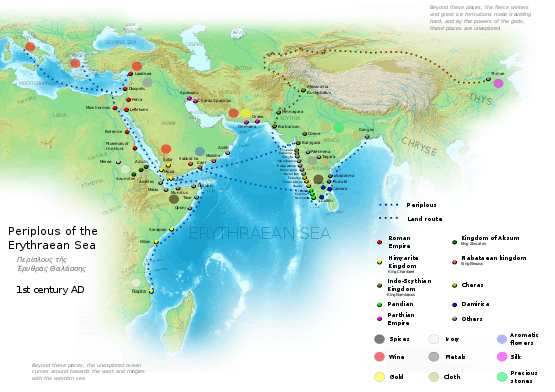Barbaria (East Africa)
Barbaria was the name used by the ancient Greeks for littoral northeast Africa. The corresponding Arabic term, bilad al-Barbar (land of the Barbar), was in use in the Middle Ages.[1]

According to the Periplus of the Erythraean Sea, a 1st-century travelogue written by a Greek merchant based in Alexandria, Barbaria extended from the border of Egypt just south of Berenice Troglodytica to just north of Ptolemais Theron. From there to the Bab-el-Mandeb was the kingdom ruled by Zoskales (possibly Aksum), after which the "rest of Barbaria" extended to Opone. This second Barbaria was the location of the so-called "far-side" ports. In the Geography of Ptolemy (2nd century), Barbaria is said to extend even further, as far south as Zanzibar, although the land south of Opone is called Azania in the Periplus.[2][3]
In the Periplus, Barbaria is said to lack central government and is ruled by local chiefs. Azania, on the other hand, is subject to the Sabaeans and Himyarites.[2] In the Periplus, the inhabitants of the first Barbaria, or the Barbarike chora (Barbarian region), include the eponymous Barbaroi (Barbarians, Berbers), but also Ichthyophagoi (fish eaters), Agriophagoi (wild beast eaters) and Moschophagoi (shoot eaters). These are probably the same people as the Trogodytes of other ancient geographers. The Moschophagoi may correspond to the Rhizophagoi (root eaters) and Spermatophagoi (seed eaters) of other geographers.[4] The first contact of the Greeks with Barbaria came in the 3rd century BC, when the Ptolemies set up bases for elephant hunting. These bases remained in use as ports for the export of myrrh and frankincense throughout antiquity. There were many smaller ports that exported tortoiseshell and ivory.[3]
The name of Barbaria is preserved today in the name of the Somali city of Berbera,[1] the city known to the Greeks as Malao.[5] Arabic sources refer to the coast as the Baḥr Berberā or al-Khalīj al-Berberī and its inhabitants as the Berbera or Berābir. They are the Somalis, distinguished from the Habash to their north and the Zanj to their south. From Arabic, this terminology for northeast Africa entered Hebrew (Barbara), Persian (Barbaristan) and even Chinese (Pi-pa-li). Most of these usages are associated with Somalia.[5] The Chinese term, although probably derived from Berbera, refers to the coast and hinterland and not just the port.[6]
See also
References
- Michael Peppard, "A Letter Concerning Boats in Berenike and Trade on the Red Sea", Zeitschrift für Papyrologie und Epigraphik 171 (2009), pp. 193–198.
- Lionel Casson (ed.), The Periplus Maris Erythraei: Text with Introduction, Translation, and Commentary (Princeton University Press, 1989), p. 45.
- Lionel Casson, "Barbaria", in Glen W. Bowersock, Peter Brown and Oleg Grabar (eds.), Late Antiquity: A Guide to the Postclassical World (Belknap Press of Harvard University Press, 1999), p. 334.
- Casson 1989, pp. 96–97.
- David M. Goldenberg, "Geographia Rabbinica: The Toponym Barbaria", Journal of Jewish Studies 50, 1 (1999), pp. 67–69.
- Paul Wheatley, "The Land of Zanj: Exegetical Notes on Chinese Knowledge of East Africa prior to AD 1500", in Robert W. Steel and R. Mansell Prothero (eds.), Geographers and the Tropics: Liverpool Essays (Longmans, 1964), pp. 139–187, at 142–43.
External links
- Periplus of the Erythraean Sea - Schoff translation